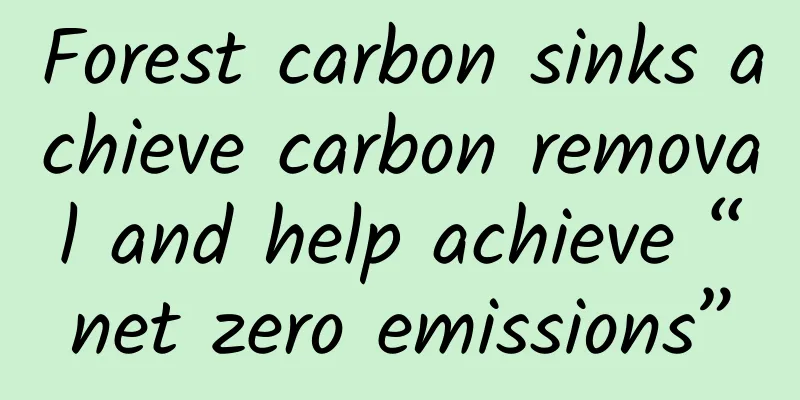Forest carbon sinks achieve carbon removal and help achieve “net zero emissions”

|
November 1 is World Afforestation Day. In addition to increasing forest coverage, improving wood production and ecological functions, afforestation also has significant "carbon sink" benefits. In order to control global warming, in addition to reducing carbon dioxide emissions, carbon dioxide removal measures can also be taken to achieve "net zero emissions". Natural ecosystems, especially forests, have significant carbon removal capabilities, which are carbon sinks. Forest plants absorb carbon dioxide from the atmosphere through photosynthesis and store it in trees, soil and wood products, thereby reducing atmospheric carbon dioxide concentration and mitigating climate change. Both the international community and my country will regard consolidating and enhancing forest carbon sinks as one of the important paths to achieve carbon peak and carbon neutrality. How forest carbon sinks mitigate climate change Forests are the largest carbon storage reservoir in terrestrial ecosystems, storing large amounts of carbon in forest biomass, dead organic matter such as litter and dead wood, and soil, both above and below ground. There is a frequent exchange of carbon dioxide between forests and the atmosphere. Forests absorb carbon dioxide through photosynthesis, and emit carbon dioxide through autotrophic respiration, heterotrophic respiration, and natural or human intervention. If the absorption exceeds the emission, it will form a carbon sink, otherwise it will become a carbon source. Therefore, forests are like sponges that absorb carbon, regulating the concentration of carbon dioxide in the atmosphere, thereby affecting climate change. Over the past 60 years, the carbon sink capacity of forests in the northern hemisphere has continued to increase, mainly due to the "fertilization effect" caused by the increase in atmospheric carbon dioxide concentrations, coupled with increased nitrogen deposition and other factors, which have enhanced the photosynthetic efficiency of plants. At the same time, carbon emissions caused by deforestation in tropical countries in the southern hemisphere have also slowed down. Since the 1980s, China's forest carbon storage has continued to grow, with the increase in forest area contributing 40% to 50% to China's forest carbon sink. In recent years, China's forest carbon sink has offset about 7% to 8% of the country's total carbon dioxide emissions during the same period. How to calculate forest carbon sinks Forest carbon sink accounting needs to distinguish between carbon sinks formed by human and natural factors. Only carbon sinks generated by direct human intervention, such as afforestation and forest management, or indirect impacts, such as forest protection, reducing deforestation, and preventing forest degradation, can offset human-generated carbon dioxide emissions and achieve carbon neutrality. Forest carbon sink accounting requires clear geographical boundaries and time periods. For example, my country's forests include tree forests, bamboo forests, and shrub forests specially specified by the state. Accounting for forest carbon sinks at the national level needs to cover all different forest types, as well as all carbon pools and greenhouse gas emission sources, to avoid duplication or omissions. In terms of time scale, forest carbon sinks will also change with changes in forest age and structure, changes in land use, and the impact of human and natural activities. Inconsistencies in data sources, time scales, boundary ranges, and accounting methods may lead to very different accounting results, or even completely opposite conclusions. In order to resolve this contradiction, the Intergovernmental Panel on Climate Change has successively issued and revised a number of practice guidelines since the 1990s, recommending that countries and regions around the world use the same methods and comparable parameters to assess carbon sinks or sources. How to increase forest carbon sinks Many studies have shown that increasing forest area through afforestation is one of the most effective ways to increase forest carbon sinks. To increase afforestation, scientific greening should be implemented under the overall national land space planning, the carbon pool capacity should be increased accurately, and the stability and durability of carbon sequestration by new afforestation should be maximized. At present, the land suitable for afforestation in China is mainly distributed in arid and semi-arid areas, and it will be difficult to expand the forest area in the future. China's forest quality is far below the global average. In the future, through precise improvement of forest quality, it has great potential for carbon sink expansion. Although deforestation will cause biomass carbon loss in the short term, the forests regenerated after deforestation often have a faster growth rate and continue to play the role of carbon sink. At the same time, wood products also have the function of carbon storage. By extending the product life and strengthening recycling, carbon can be stored for a long time, which indirectly extends and expands the boundaries of forest carbon sinks to a certain extent. (The first author Zhu Jianhua is the deputy director of the Forest and Grassland Carbon Sink Research Institute Office and a researcher at the Chinese Academy of Forestry; the second author Zeng Lixiong is an associate researcher at the Chinese Academy of Forestry; the third author Xiao Wenfa is the deputy director of the Forest and Grassland Carbon Sink Research Institute and the deputy director of the Chinese Academy of Forestry) |
Recommend
Unveiling Omicron: Will it be the last coronavirus variant to wreak havoc around the world?
Written by: Zhu Hengheng Editor: Wang Haha Layout...
Solution sharing | Internet home improvement brand planning and marketing promotion suggestions!
Competition is fierce in the new media marketing ...
Keyword selection tips for bidding accounts!
SEM account optimization generally refers to the ...
Xi'an mid-to-high-end sauna and SPA studio, so comfortable that I went there several times a week
Xi'an Bath Club East Suburbs, South Suburbs, ...
Why does a cherry-flavored drink taste like almonds?
If you have ever tasted those "cherry-flavor...
Talking about Tint in Android Material Design
What is Tint When I first came across the word Ti...
How to design a landing page that increases conversion rate by 30-50%? !
In the process of display advertising , when you h...
OPPO executives will join Xiaopeng Motors. What does the convergence of digital and automotive circles mean to users?
Have you noticed that many bloggers and big Vs in...
Can the “erratic” heavy rainfall become the “terminator” of the heat wave?
Recently, "high temperature heat wave" ...
The Qin Dynasty fell? Maybe it’s not entirely Qin Shi Huang’s fault…|BoLan Daily
The Qin Dynasty fell? Maybe it’s not entirely Qin...
Chengdu Tea Tasting has its own studio, where you can experience unexpected services while drinking tea
Chengdu Tea Pincha has its own studio: Senior age...
What are the functions of the community property management mini program? How much does it cost to develop a property management app?
In order to improve the management efficiency of p...
People's Daily comments on Bitcoin: The so-called advantages are all a cover for speculation
In the past 2017, the soaring and plummeting of B...
How much does it cost to develop a geotechnical building materials app in Changchun?
There are two types of WeChat applet development ...
This preservative commonly found in cakes and breads is actually a "deadly assassin"?
It has been almost half a month since the Mid-Aut...









